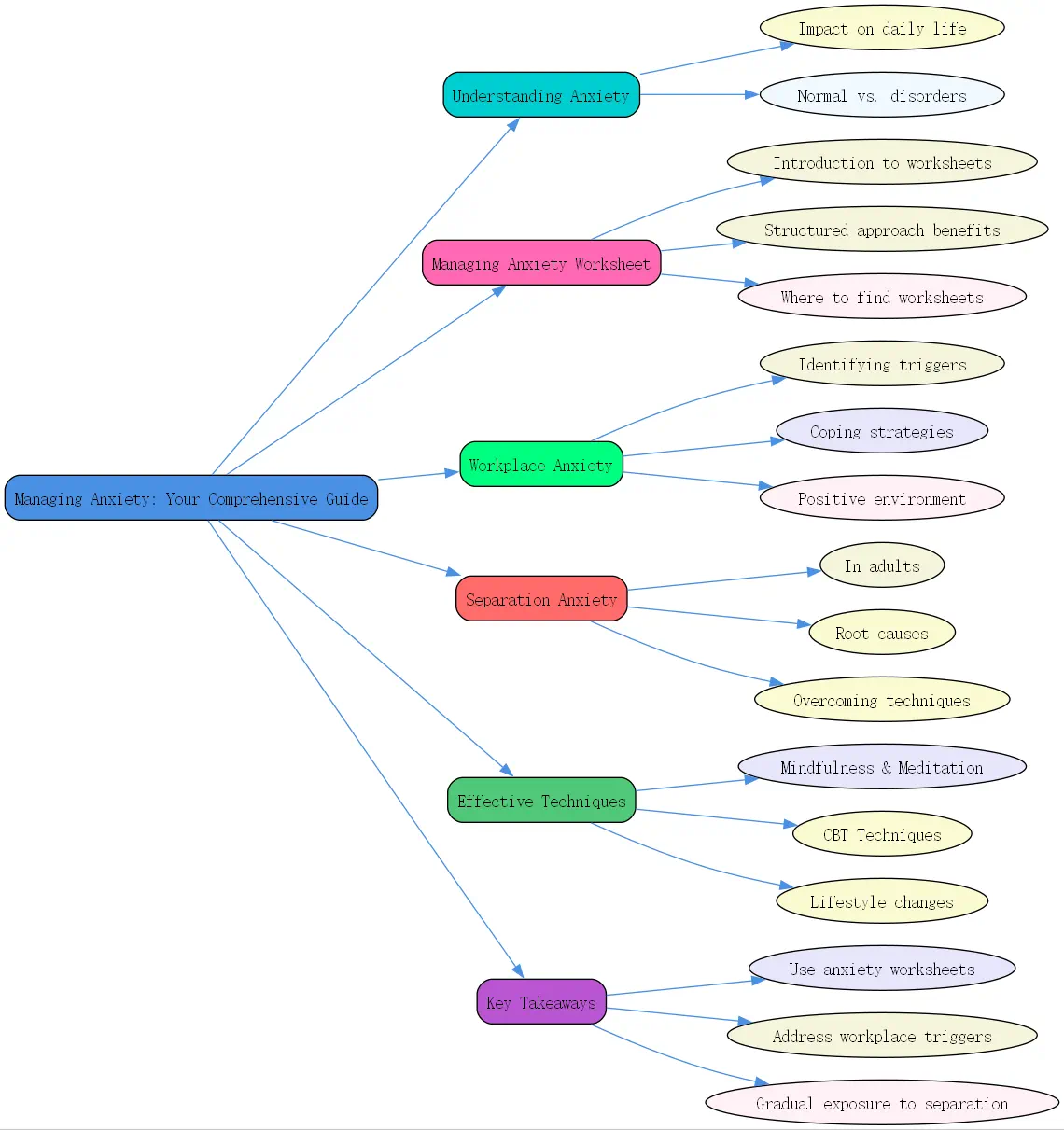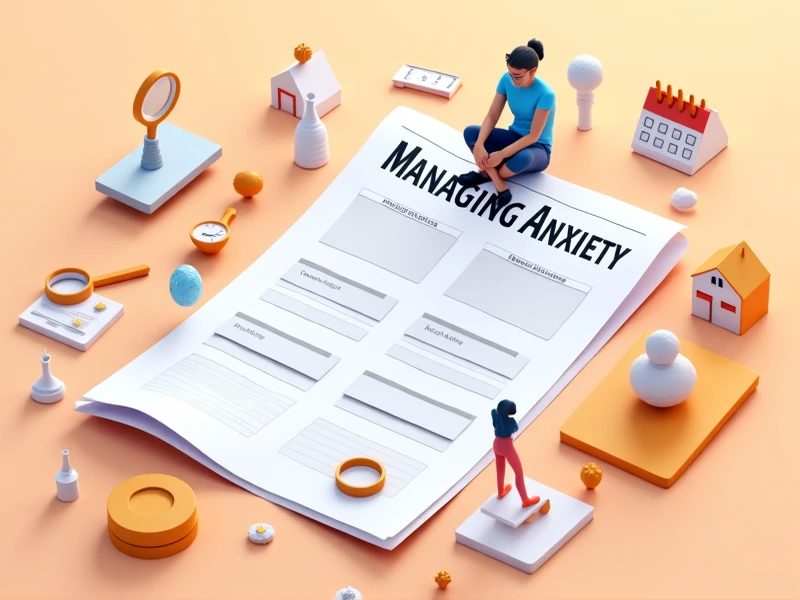Anxiety is a natural response to stress and challenges, but when it overwhelms your daily life, it becomes a significant concern. Whether it’s managing workplace anxiety or tackling separation anxiety, finding comprehensive strategies to address it is key to improving your mental health. In this guide, we’ll explore proven methods to mitigate anxiety, highlight strategies including managing anxiety worksheets, and provide tips tailored to different situations.
Understanding Anxiety and Its Impact

Overview of Anxiety and Its Effects on Daily Life
Anxiety is an emotional state characterized by worry, fear, or tension. While occasional feelings of anxiety are normal, chronic anxiety can disrupt your personal and professional life. It affects physical health, emotional stability, and even relationships.
Some individuals experience symptoms like insomnia, digestive issues, or intrusive thoughts. If unchecked, these challenges may escalate into anxiety disorders, where everyday scenarios become overwhelming. Recognizing the tipping point between normal anxiety and an anxiety disorder is essential to seek appropriate intervention.
Differentiating Normal Anxiety from Anxiety Disorders
Normal anxiety can occur before stressful events, such as deadlines or social interactions, and is temporary. On the other hand, anxiety disorders are long-lasting and can cause persistent feelings of dread or fear even in non-threatening situations.
Types of anxiety disorders include generalized anxiety disorder (GAD), panic disorder, and separation anxiety. Managing anxiety requires understanding its implications and how they differ across individuals and situations.
Managing Anxiety Worksheet: Your First Step
Introduction to Using Worksheets for Anxiety Management
Worksheets designed for managing anxiety provide structured frameworks to analyze and address your feelings. They encourage reflection, helping you pinpoint triggers and understand your emotional responses better. Whether you’re addressing workplace anxiety or separation anxiety, worksheets can serve as powerful tools.
Benefits of a Structured Approach to Understanding Your Anxiety
Using a managing anxiety worksheet empowers individuals to create actionable plans for dealing with their concerns. Benefits include:
- Increased self-awareness: Worksheets guide you to recognize patterns in your anxiety responses.
- Custom solutions: They help tailor coping techniques to your specific needs.
- Progress tracking: Monitor improvements in how you handle triggers over time.

Where to Find Effective Managing Anxiety Worksheets
Resources like BrainTalking offer expertly crafted managing anxiety worksheets tailored to various scenarios. You can also access worksheets through online psychology websites, mental health professionals, or apps focused on personal growth and anxiety management.
Managing Workplace Anxiety
Identifying Workplace Anxiety Triggers
Workplace anxiety is a common issue, heightened by stressful deadlines, unclear expectations, and interpersonal conflicts. Key triggers include:
- Excessive workload: Juggling too many tasks within limited timeframes.
- Weak boundaries: Feeling obligated to answer emails or work outside official hours.
- Office dynamics: Tensions with colleagues or communication challenges often spark unease.
Conducting self-assessments can help you pinpoint situations that cause stress. Keep a journal or use managing anxiety worksheets to categorize these triggers, identifying both subjective perceptions and external causes.
Strategies for Coping with Workplace Anxiety
Effective coping mechanisms can transform your workplace experience. Start with these strategies:
- Time management and prioritization: Use tools like to-do lists or scheduling apps to organize your tasks. Focus on high-impact activities first to relieve overwhelming pressure.
- Mindfulness practices: Incorporate breathing exercises or short meditation breaks into your workday to refocus when anxiety arises.
- Clear communication: Set boundaries with colleagues and articulate your expectations clearly. This minimizes misunderstandings and ensures balanced demands.
Creating a Positive and Supportive Work Environment
A strong workplace culture can mitigate anxiety and foster support. Some suggestions include:
- Open communication: Encourage transparent conversations about workload expectations and mental health.
- Team-building initiatives: Forge bonds with coworkers to reduce tensions and boost productivity.
- Seek HR or employee assistance programs: Many companies provide resources specifically for managing workplace anxiety, offering professional guidance and tools.

Managing Separation Anxiety
Understanding Separation Anxiety in Adults
Though often associated with children or pets, adults can also experience separation anxiety. This situation arises when individuals feel extreme distress during periods of separation from loved ones, whether due to extended travel, relocation, or relationship changes. Symptoms might include excessive worry, restlessness, or difficulty concentrating.
Identifying the Root Causes of Separation Anxiety
Separation anxiety often stems from past insecurities, such as fear of abandonment, unstable relationships, or traumatic experiences. Social isolation can further exacerbate feelings, making separation more daunting. Recognizing these root causes is the first step toward effective management.
Techniques for Overcoming Separation Anxiety
Managing separation anxiety often involves practicing gradual adjustment:
- Gradual exposure: Instead of abrupt separations, plan shorter periods apart before transitioning to longer durations.
- Coping mechanisms: Build hobbies and self-soothing techniques like journaling or creative outlets to reduce dependency.
- Strong support systems: Cultivate close relationships with friends or mentors to rely on during separation periods.
Managing Separation Anxiety in Children and Pets
Children and pets require specialized approaches when dealing with separation anxiety:
- Positive reinforcement: Reward calm behavior when they adapt to being apart.
- Consistent routines: Provide stability through structured schedules, like consistent bedtime or playtime routines.
- Professional help: Seek therapists or trainers, particularly for extreme cases like destructive behaviors in dogs or intense anxiety in children.
Effective Techniques for Managing Anxiety
Mindfulness and Meditation Practices
Mindfulness encourages living fully in the moment, a practice especially effective for easing anxiety. Techniques include:
- Guided meditation: Apps or programs offer relaxation exercises that are simple to incorporate daily.
- Micro-mindfulness: Take brief pauses throughout the day to reset mentally. Deep breathing or observing your surroundings for a few seconds can make a significant impact.
Integrating mindfulness practices into daily routines builds resilience over time. Whether during travel, work transitions, or family obligations, the benefits persist.
Cognitive Behavioral Therapy (CBT) Techniques
CBT is highly effective in managing anxiety by identifying irrational thoughts. Key techniques include:
- Challenging negative thought patterns: Replace exaggerated fears (like 閳ユ窔’ll fail horribly閳? with positive affirmations (閳ユ窔 can prepare and succeed閳?.
- Behavioral experiments: Test scenarios to combat anxiety-provoking assumptions. For example, rehearse presenting at a small group meeting before delivering to a larger audience.
Through CBT, individuals transform damaging outlooks into progressive solutions for long-term relief.
Lifestyle Changes for Anxiety Management
Simple lifestyle tweaks can dramatically reduce overall anxiety levels:
- Diet and exercise: Include nutrient-rich foods and regular physical activities in your day. These improve mood and decrease stress hormones.
- Sleep hygiene: Avoid screen time close to bedtime, focus on calm surroundings, and maintain a consistent sleep schedule for restorative rest.
- Limit caffeine and alcohol: Too much caffeine heightens anxiety, while alcohol disrupts stability. Moderation ensures mental clarity.
Bullet-Point Actionable Takeaways
- Use managing anxiety worksheets to structure and track your progress.
- Pinpoint your workplace anxiety triggers and address them with mindful communication or scheduling techniques.
- Gradually expose yourself to separation scenarios to ease intense feelings over time.
- Implement mindfulness practices daily to boost emotional resilience.
- Leverage CBT techniques to challenge irrational thought patterns.
- Improve diet, exercise, and sleep hygiene to regulate physical sources of anxiety.

Q&A Section
Q: How can I start effectively using managing anxiety worksheets for workplace anxiety? A: Start by identifying specific workplace stressors, such as tight deadlines or interpersonal conflicts. Divide your worksheet into sections like triggers, symptoms, and solutions. Use the 閳ユ涪riggers閳?column to jot down what causes stress and include actionable solutions for each, such as delegating tasks or improving time management. Over time, evaluate what works best to refine your approach. BrainTalking offers printable worksheets that guide you further.




